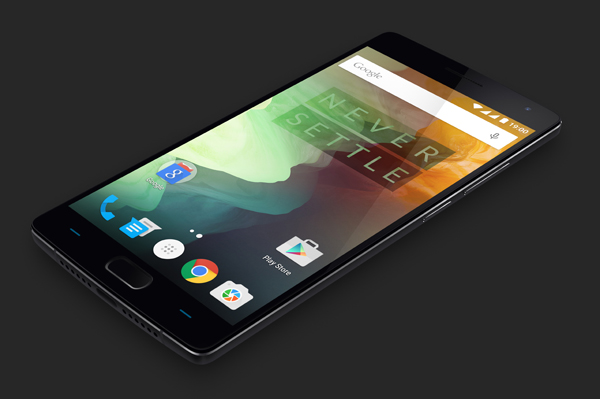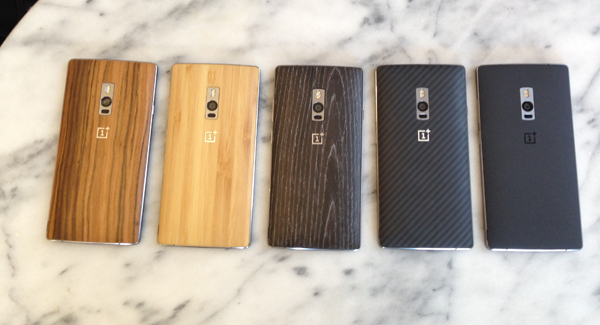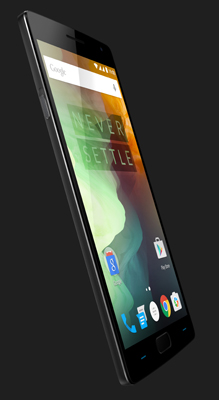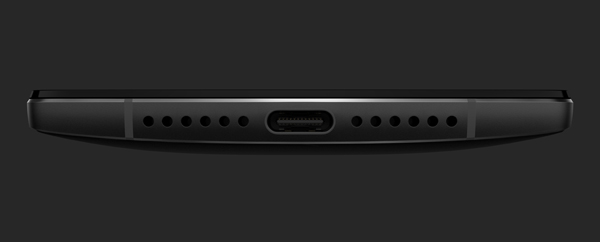OnePlus 2 Hands-on: Better Camera, New OxygenOS
OnePlus’s latest smartphone replaces Cyanogen with its own take on Android, bolsters the rear camera and adds your choice of covers.
Sure, the OnePlus 2 sports a premium new aluminum-magnesium-alloy body and fancy optional covers, including bamboo and Kevlar. But the biggest changes to OnePlus' self-described "flagship killer" are on the inside, in the form of an improved camera, a new operating system and other enhancements. Starting at $329 (16GB), this is a device that's designed to go toe-to-toe with the top smartphones on the market.
Only a thorough review will reveal if this sequel is up to the task. But even after just a brief tour of the OnePlus 2, I saw plenty of new features that make this handset worthy of your attention.
Key Specs
As expected, the OnePlus 2 is powered by a Snapdragon 810 chip with an Adreno 430 graphics processor and 4GB of LPDDR4 RAM.

Like last year's OnePlus One, the OnePlus 2 features a 5.5-inch 1920 x 1080-pixel display, though its listed brightness of 600 nits would be considerably brighter than the 432 nits we measured on its predecessor.
MORE: Best Smartphones on the Market Now
A 64GB version of the OnePlus 2 is available for $389 — more expensive than the original $350 price tag for the 64GB OnePlus One. The phone becomes available in the U.S. on August 11. OnePlus says a $329 16GB OnePlus 2 is coming as well.
However, the specs don't really tell the story of the OnePlus 2. It's when you hold the phone in your hands when you begin to realize how it stands apart from its predecessor.
A New Feel for the OnePlus 2
While the 6 x 2.9 x 0.4-inch OnePlus 2 is just a little thicker than the One, it's a far more substantive device. That's because OnePlus has swapped in an aluminum-magnesium-alloy frame for the plastic one that adorned the One. The new frame adds a little bit of weight to the OnePlus 2 — it weighs 6.17 ounces, compared to the One's 5.7 ounces — but it also gives the phone some welcome heft missing from plasticky Android devices. Nevertheless, other Android phones with 5.5-inch displays, such as the 4.9-ounce Alcatel Onetouch Idol 3, are much lighter.

The OnePlus 2 keeps the sandstone-black backing of its predecessor, which makes the phone easy to grip. But you have other options in case you'd prefer a different cover. The bamboo, black apricot and rosewood covers are made of actual wood, while a Kevlar version features that synthetic fiber. The covers cost $27 each and are available now from OnePlus.
Faster Than Touch ID
A less obvious change is the OnePlus 2's capacitive fingerprint sensor that's now a part of the phone's home button and lets you securely unlock your device with just a press. I didn't have the chance to configure the sensor during my tour of the OnePlus 2, but OnePlus did demo how it can wake up your phone in 0.5 seconds — faster than Apple's Touch ID feature, according to OnePlus. You can save up to five fingerprint profiles on the OnePlus 2.

OnePlus added an Alert Slider to the left side of the phone that allows you to toggle among different notification settings. You can set the OnePlus 2 to receive all notifications, priority notifications from select contacts or no notifications at all. The idea is you'll be able to reach into your pocket and adjust settings with the Alert Slider without ever having to take out your phone and dive into settings.
Meet OxygenOS
That kind of streamlined navigation is consistent with changes to the operating system powering the OnePlus 2. OnePlus has done away with Cyanogen, opting instead for its own OS based on Android 5.1. OnePlus calls it OxygenOS. "It's really light and not full of bloatware," OnePlus co-founder Carl Pei told me during a demo of the OnePlus 2.

Even with the new OS, the OnePlus 2 retains the One's lock-screen gestures — for example, you can draw a "V" to turn on the flashlight, or make a circle to launch the camera. OnePlus added some other interface tweaks, such as a double-tap anywhere on the screen to bring down the navigation bar. You can use the phone's settings to flip around the on-screen Recent and Back buttons. You can also customize the color of the front-facing LED. For example, you can set it to change colors to alert you to different app notifications or the status of the phone's battery. The OnePlus 2 will be one of the first phones to offer Dark Mode, a feature slated for Android M that makes screens easier to view at night.
With OxygenOS, OnePlus is also introducing a feature called Shelf. Still in beta as the OnePlus 2 launches, Shelf is a panel containing widgets for your most used apps and contacts, putting all the information you frequently access in one spot. OnePlus says it's actively seeking feedback from users on Shelf so it can continue to add to the feature over time.
Building a Better Camera
Like the OnePlus One, OnePlus' latest smartphone features a 13-megapixel rear camera. But merely listing megapixels would sell the OnePlus 2 short on the improvements OnePlus made to its phone's picture-taking prowess.
The OnePlus 2 camera adds a laser focus system for more precise focus, plus an optical image stabilization system to compensate for photos taken with shaky hands. In addition, the OnePlus 2 improves over the OnePlus One in the ability to take photos in low light, adding a 1.3-micron sensor that lets in more light.
MORE: Best Smartphone Cameras
Pei said that, in addition to the hardware improvements, OnePlus has a dedicated portion of its software team working exclusively on the OnePlus 2's camera and photo software, so look for improvements to the phone's picture-taking features even after it hits the market.
We didn't have the chance to put the OnePlus 2's souped-up camera to the test. But as camera and photo features increasingly become a way for phone makers to distinguish their devices, we're interested to see how the OnePlus 2 measures up to the top camera phones on the market.
USB-C, Beefier Battery
As expected, the OnePlus 2 adds a USB Type-C charging port, which saves you from having to fumble with inserting your charging cable a specific way. But OnePlus also makes the Type-A end of its charging cable reversible as well, meaning you'll be able to easily insert it into a computer or wall charger. In addition to including the cable with its new phone, OnePlus says it plans to make its cable available for purchase so that more people are encouraged to adopt USB Type-C.

The OnePlus 2's 3,300-mAh battery is larger than the OnePlus One's 3,100-mAh battery. However, the battery life should be similar, the company says — you'll still be able to get a day's worth of use out of a full charge.
The OnePlus 2 can also support two SIM cards — ideal for travelers who don't want to keep swapping in a new SIM every time they land in a new country.
How to Get It
As with the initial launch of the OnePlus One, you'll need an invite to get your hands on the OnePlus 2, though the company promises a less time-consuming process this time around. The OnePlus website will feature a reservation list, where you can sign up and receive an invitation to buy the OnePlus 2 as soon as it becomes available.
Anyone who buys a OnePlus 2 will also be able to send invitations to friends, and OnePlus promises that sharable invites will be available more quickly. OnePlus also plans to make invitations available through online contests and social media.
OnePlus says pop-up stores are coming to New York and San Francisco, plus seven other cities around the world. There, you'll be able to get some hands-on time with the OnePlus 2.
Outlook
The OnePlus One made its mark by offering flagship features at a low price. Even with its slightly higher price tag — which is understandable, given the components OnePlus is now using — the OnePlus 2 looks to continue that trend. Whether it can build on the OnePlus One's success will hinge on whether the more powerful camera and the new OxygenOS deliver on their promised improvements.
- Best Cheap Unlocked Smartphones
- The Best Android Apps to Try Today
- 10 Reasons Android Beats the iPhone
Philip Michaels is a senior editor at Tom's Guide. Follow him at @PhilipMichaels. Follow Tom's Guide at @tomsguide, on Facebook and on Google+.
Sign up to get the BEST of Tom's Guide direct to your inbox.
Get instant access to breaking news, the hottest reviews, great deals and helpful tips.
Philip Michaels is a Managing Editor at Tom's Guide. He's been covering personal technology since 1999 and was in the building when Steve Jobs showed off the iPhone for the first time. He's been evaluating smartphones since that first iPhone debuted in 2007, and he's been following phone carriers and smartphone plans since 2015. He has strong opinions about Apple, the Oakland Athletics, old movies and proper butchery techniques. Follow him at @PhilipMichaels.

